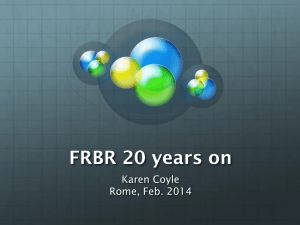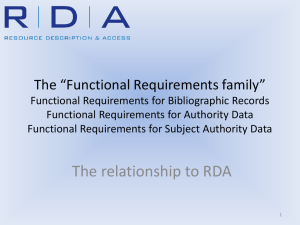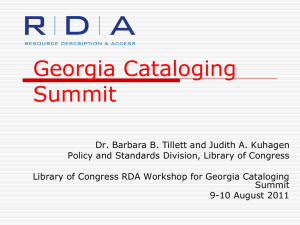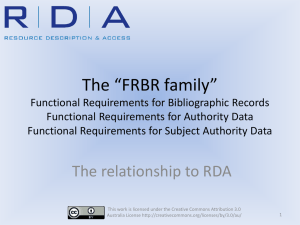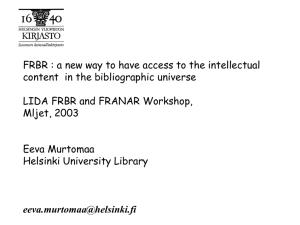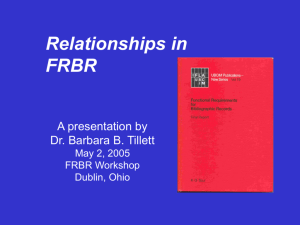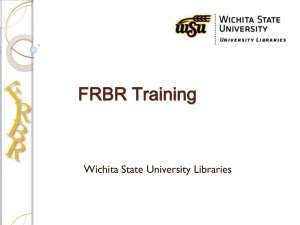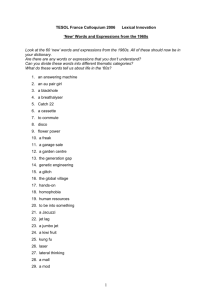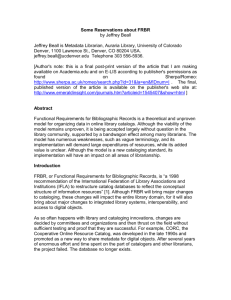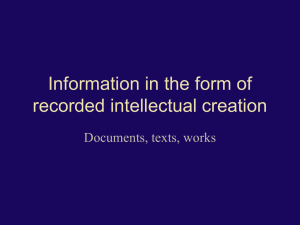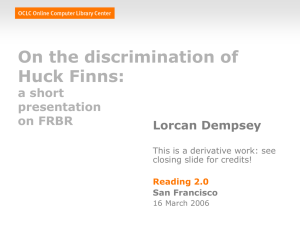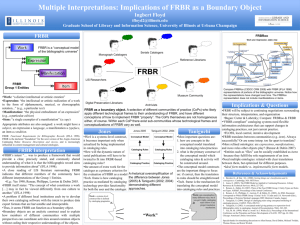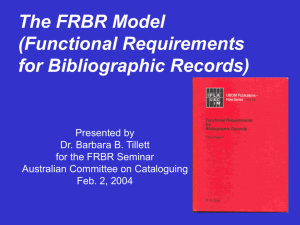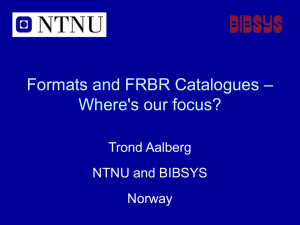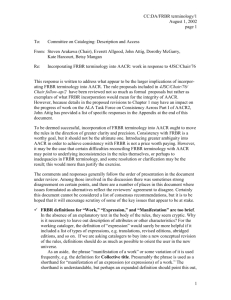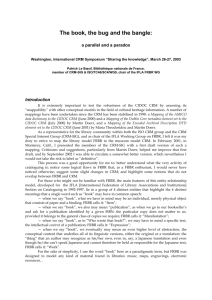DOC
advertisement
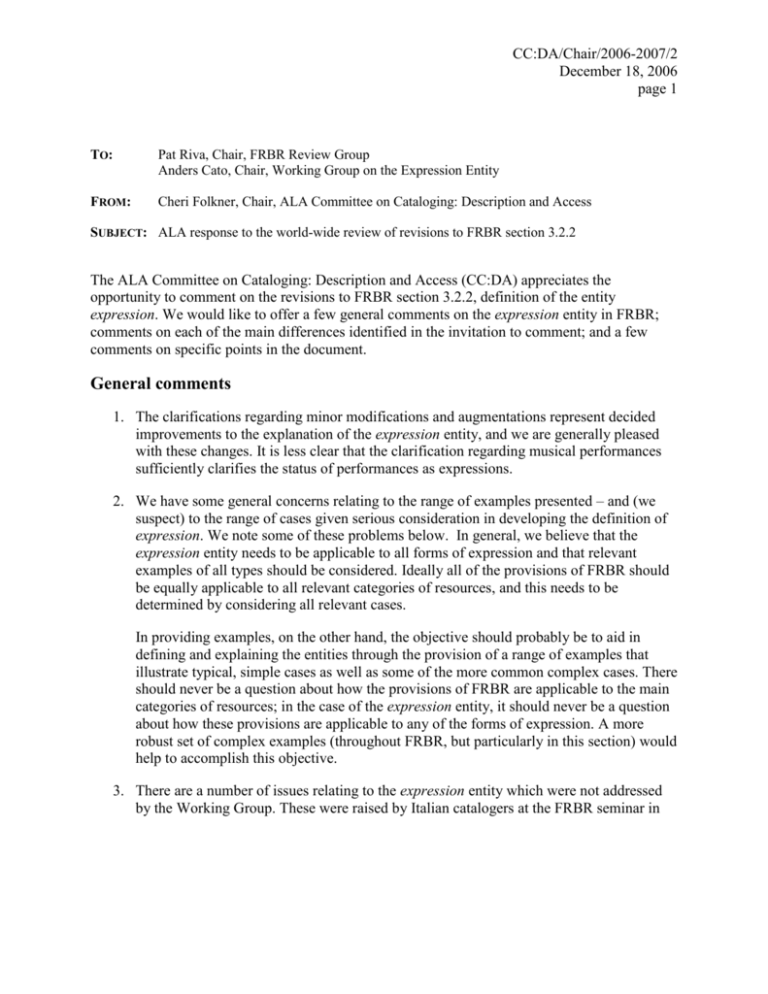
CC:DA/Chair/2006-2007/2 December 18, 2006 page 1 TO: Pat Riva, Chair, FRBR Review Group Anders Cato, Chair, Working Group on the Expression Entity FROM: Cheri Folkner, Chair, ALA Committee on Cataloging: Description and Access SUBJECT: ALA response to the world-wide review of revisions to FRBR section 3.2.2 The ALA Committee on Cataloging: Description and Access (CC:DA) appreciates the opportunity to comment on the revisions to FRBR section 3.2.2, definition of the entity expression. We would like to offer a few general comments on the expression entity in FRBR; comments on each of the main differences identified in the invitation to comment; and a few comments on specific points in the document. General comments 1. The clarifications regarding minor modifications and augmentations represent decided improvements to the explanation of the expression entity, and we are generally pleased with these changes. It is less clear that the clarification regarding musical performances sufficiently clarifies the status of performances as expressions. 2. We have some general concerns relating to the range of examples presented – and (we suspect) to the range of cases given serious consideration in developing the definition of expression. We note some of these problems below. In general, we believe that the expression entity needs to be applicable to all forms of expression and that relevant examples of all types should be considered. Ideally all of the provisions of FRBR should be equally applicable to all relevant categories of resources, and this needs to be determined by considering all relevant cases. In providing examples, on the other hand, the objective should probably be to aid in defining and explaining the entities through the provision of a range of examples that illustrate typical, simple cases as well as some of the more common complex cases. There should never be a question about how the provisions of FRBR are applicable to the main categories of resources; in the case of the expression entity, it should never be a question about how these provisions are applicable to any of the forms of expression. A more robust set of complex examples (throughout FRBR, but particularly in this section) would help to accomplish this objective. 3. There are a number of issues relating to the expression entity which were not addressed by the Working Group. These were raised by Italian catalogers at the FRBR seminar in CC:DA/Chair/2006-2007/2 December 18, 2006 page 2 Florence in 2000.1 They show that expression is a complex entity and suggest that more levels are needed within expression. It is certainly clear that there are a number of factors that distinguish expressions (form of expression; changes or revisions in intellectual or artistic content; transformations in the way the work is expressed, such as translation or arrangement); in any given case, more than one of these factors may apply. Is the expression the end result of applying all the factors? Or is there a conceptual value in making intermediate groupings? If so, is there a hierarchy of factors that should be applied consistently or should the hierarchy depend on the range of expressions of the given work? For example, should all textual expressions (regardless of edition) be grouped separately from performances or should all expressions of a first edition (regardless of form) be grouped separately from all expressions of a revised edition? All of this might be left to particular implementations, but we suggest that the conceptual model has something to offer here in terms of providing a more sophisticated set of conceptual tools for analyzing and determining these questions. Comments on the main differences 1. Slight modifications: We welcome this change that allows minor modifications to be treated as variations within the same expression. Not only is it difficult to determine whether a particular manifestation contains any modifications, but the objective of grouping together those manifestations containing substantially the same expression of a work is best achieved by ignoring minor changes – or, when discovered, noting them within the description of the manifestation. We do note that the language about minor changes uses examples that are only relevant to textual realizations; as noted above, the general utility of FRBR would be enhanced by a more concerted effort to include a wider range of exemplary characteristics. We also note that the language about minor changes cannot be precisely or quantitatively defined. This is perhaps not necessary in a conceptual model, but it does underline the need for operational definitions in any application of the model (point #4 below). 2. Augmentations: We had a great deal of difficulty in understanding and evaluating the new provisions relating to augmentations. First, we believe that the statement added at the end of the second paragraph in 3.2.2 does not precisely state the intent of the changes. Although it is true that augmentations may be treated as separate expressions of their own works, the point that needs to be made here is that the presence of such augmentations in a manifestation does not affect the decision about whether there is a new expression, or (to state this positively) that the “Osservazioni su Functional Requirements for Bibliographic Records, Final Report = An Italian Comment on Functional Requirements for Bibliographic Records, Final Report.” In FRBR Seminar : Functional Requirements for Bibliographic Records = Requisiti funzionali per record bibliografici : Florence, 27th–28th January 2000 / edited by Mauro Guerrini, 151–160. 1 CC:DA/Chair/2006-2007/2 December 18, 2006 page 3 decision about whether a manifestation embodies a new expression of a work is based solely on the nature and content of the expression of the “primary” work and not on the presence in the manifestation of expressions of other works. How one treats the augmentation is a secondary issue here; the main point is how one determines whether there is a new expression of the “primary” work. In this regard, ALA agrees with the intent of the Working Group to clarify that the presence of augmentations does not ipso facto create a new expression. Second, because of the language in section 3.2.2 about making separate bibliographic records, it is too easy to get the impression that catalogers must treat augmentations as separate entities and must make separate records. We hope that this is not the intention. Having determined that the augmentation is an expression of a separate work, the cataloger may make a separate description, or may include a work-identifier or expression-identifier (typically an author-title heading) or may simply transcribe the information about the augmentation that appears in the manifestation, or may ignore the augmentation completely. These are application decisions, and the model should not impose any demands; the model provides the conceptual underpinning for whatever application decision is made. Furthermore, we feel that the question of the number of bibliographic records resulting from particular applications of the model needs to be dealt with more generally and at several places in the FRBR document (most importantly, in section 3.2.3, Manifestation). If the question of the number of bibliographic records has any place in the FRBR conceptual model, any discussion of the issue needs to begin with the general principle that separate bibliographic records are typically made for distinct manifestations. Third, we have problems with the phrase “not integral to the intellectual or artistic realization of the work.” We agree with Martha Yee that some features may be integral to the expression and should be a factor in determining whether there is a new expression. Only those features that are clearly attributes of the manifestation and are not integral to either work or expression should be discounted. Consideration of a wider variety of nontextual expressions might clarify this situation. For example, the particular words to a piece of vocal music are not integral to the work (spoken or sung text may be revised or translated), but they are integral to the expression and should not be treated as augmentations. Taking another example, most silent films are created to be accompanied by music; the particular musical accompaniment is not integral to the work. However, it is likely that such accompaniment should be considered as integral to the expression (particularly if the expression is the recorded sound and video of the film). Although the question of what is integral cannot be specified with complete precision (and thus must be subject to application decisions), the way in which this factor is described in the definition of expression in 3.2.2 should be clarified. Fourth, we note that the examples of augmentations in the addition to the second paragraph of 3.2.2 are only relevant to textual realizations. The utility of FRBR would be CC:DA/Chair/2006-2007/2 December 18, 2006 page 4 enhanced by wider range of examples, and the clarity of its provisions (as noted in the last paragraph) would be enhanced by careful consideration of cases of non-textual forms of expression. 3. Musical performances: The change from “performance” to “music as performed” does serve to make a clear distinction between the form of work and the form of expression; in fact, “musical work as performed” would be even clearer. However, it is not clear that this change sufficiently clarifies the status of performances as expressions. Although it is true that the performance constitutes an expression, it is not clear that any performance can exist independently of its realization in a particular form. Thus the expression in the case of the Schubert example is not just the musical work as performed by a particular set of performers, but the musical work as performed by a particular set of performers and captured either as recorded sound or moving image. This conceptualization would not only more completely identify the expression as a whole, but would help to integrate the various aspects of the expression entity noted in our general comments. It is not clear to us why these revisions are limited to musical performances. We suspect that performances of dramatic texts, for example, raise the same set of issues, and we suggest that FRBR should deal with both. 4. Operational decisions: ALA agrees with the Library of Congress that the revised text does not “explicitly acknowledge that cataloguing agencies will make operational decisions on expression boundaries.” However, we do agree that the model will require such application decisions, particularly because it uses language about “minor changes” and “not integral to the intellectual or artistic realization” that cannot be precisely described at a conceptual level, but must be defined in an operational context. A more general and explicit statement of this would be welcome, preferably in Section 2, Objectives, Scope, and Methodology. Specific comments 1. The reference to the treatment of minor variations in describing rare material does not go far enough. In the new fourth paragraph in 3.2.2, we suggest that “early printed books” might be a better example than “early texts of rare manuscripts”; rare manuscripts of the same work will always exhibit differences, and probably should be treated as distinct expressions. In the case of rare books, differences are typical, and different institutions will have different policies about whether to treat them as distinct expressions. The new paragraph on variations within the same expression could also go farther. There are unusual cases in which each copy of a rare book might be treated as a distinct expression; for instance, the Folger Shakespeare Library has many copies of the First Folio, each of which is separately described in order to identify the state of each individual folio sheet that makes up each copy. Thus it is not unusual in specialized catalogues to make separate descriptions for variants within an expression, and in some cases this may even be extended to individual copies. CC:DA/Chair/2006-2007/2 December 18, 2006 page 5 2. We agree with the Library of Congress that the Schubert example is incorrect. We support the revisions suggested by the Library of Congress, but we suggest that an example with more straight-forward performing forces (such as a string quartet) might make the point better by avoiding confusing detail. 3. We agree with the Library of Congress that the language referring to “editions” and to “publications” in the 5th and 6th paragraphs of the revised text is problematic. Although we do not necessarily endorse the specific text proposed by LC, we do feel that further work is needed on the wording of these paragraphs. 4. We also agree with the Library of Congress that the Bach example on p. 21 is confusing, and we support their suggested revisions.
